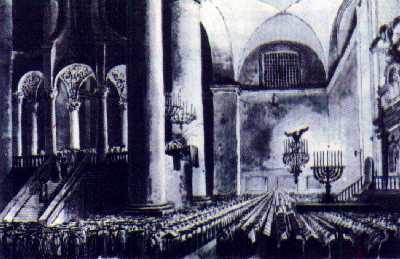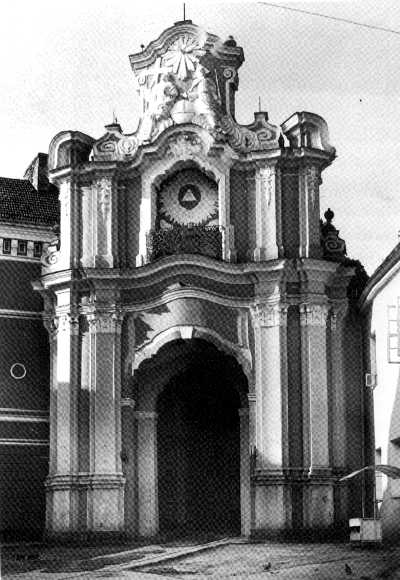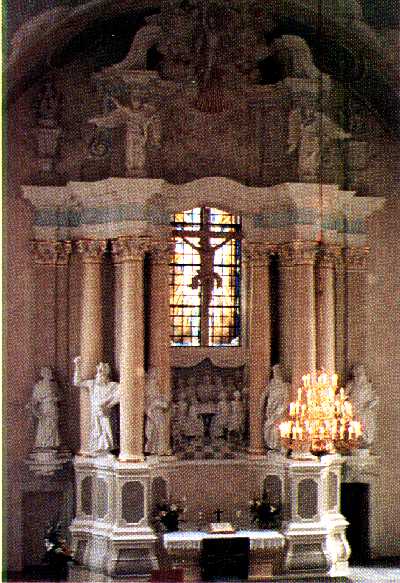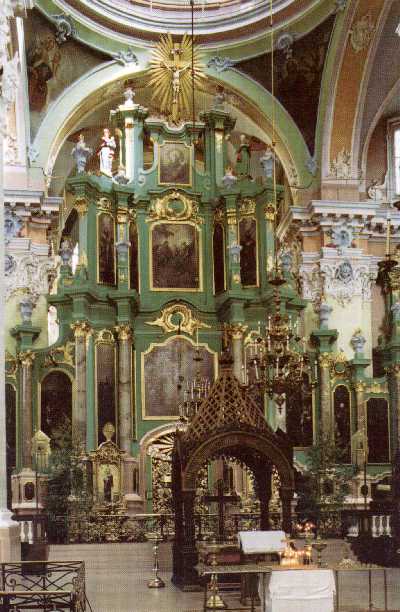
The interior of the old synagogue of Vilnius, after F. Smuglewicz, 1786
The spirit of the Baroque
References:Famous baroque instances in Vilnius:
Following [1]:
To follow the baroque route through Europe, one must use a map of the seventeenth or eighteenth century. State borders, place names, panoramas of larger towns of that time evoke a world shaped by baroque monuments from Naples to Kamenec Podolsk, from Superga to Ruzanai, from Turin to Vilnius. Anyone interested in Lithuanian baroque will find old maps very useful, as ethnic Lithuania was the centre of the multinational and multireligious Grand Duchy of Lithuania in the baroque era. To speak about "Lithuanian baroque" is impossible without taking into account the larger territory of that period and its unique cultural characteristics.
To take in the spirit of Lithuanian baroque, you need only walk through Vilnius Ausros Gate, and turn to face the chapel. There, you will find yourself in a unique centre of baroque of the Grand Duchy of Lithuania. On the left you will see the Church of St. Theresa and the monastery of the Barefoot Carmelites, on the right - the gate of the Basilian monastery of the Holy Trinity of Greek Catholics (Unitarians), and further back - the Russian Orthodox Church of the Holy Spirit. All are in the baroque style. Unfortunately, only a picture at the Jewish Museum remains of another great baroque monument, the synagogue that stood nearby. Imagine yourself back in the seventeenth century, and you can see the synagogue with a large Jewish community gathered under its vaults; you can also see Luheran, Calvinist, Tartar, and Karaime temples.
The seventeenth and eighteenth centuries in Lithuania were already marked by tensions between the various denominations, all striving for equality. The tensions were greater to the west and east of the Grand Duchy of Lithuania. Yet the Commonwealth of Lithuania and Poland still fostered a federal and democratic spirit, while baroque in these lands fused different ethnic and religious elements without unifying them. Baroque may have thrived in the Grand Duchy of Lithuania partly due to its openness to expressive motifs and foreign influences.
Nowadays many envisage the multifaceted reality of Central and Eastern Europe a dream expressed through baroque. The tourist following the route of baroque from Italy or South Germany via Prague and Krakow to Vilnius and even farther East, to the present large territories of Byelorussia and Ukraine, and to the fortresses of Vitebsk and Kamenec Podolsk, will not feel he has gone off track. Landscape, language, and faces will change; but the baroque pilgrim travelling from one country to the next will see a continuity of architecture and style in the graceful contours of church towers, palace facades, fountains, and chapels... In a certain sense, baroque Europe and the greater baroque world are the Europe and the world of our dreams: multinational and multifaceted, sometimes rich, sometimes poor, but homogeneous from the Mediterranean to the Baltic and Black seas, from the Ukraine to Brazil... It is a Europe and a world in which one feels at home, a Europe and a world capable of maintaining a balance between variety and homogeneity.
Some elements of this three-hundred-year-old reality in Lithuania survive only in street and district names, leaving with us today a sense of loss and guilt. We can only try to imagine towns with large Jewish communities, and Tartar, Karaime, and German neighbourhoods as a reality rather than a vague memory.
What can be called the dialect of Lithuanian baroque, in the European context is actually the language of the Grand Duchy of Lithuania. Vilnius was the centre, the largest town, with many ties to the West, to Krakow, the other capital of the Commonwealth, and to the eastern territories of the state. These territories bordered on Moscow's Russia and the Turkish Empire, Porta. The influence of both neighbours, at times friendly, at times militant, was felt in the country's customs, clothing, and everyday life. Artistic expressions of the Oriental world enrich the vernacular of the Grand Duchy of Lithuania with their exoticism. Yet the overall syntax of the local cultural language is Western. It reflects the strenghtening ties with Western Europe throughout the seventeenth and eighteenth centuries.
Baroque was a great cultural epoch which left deep marks on Lithuania's cultural mentality.

The interior of the old synagogue of Vilnius, after F. Smuglewicz, 1786

The gate of the Basilian monastery of Greek Catholics (Unitarians)

The altar in the Evangelican Lutheran Church

The wooden iconostasis of the Orthodox church of the Holy Spirit
Famous baroque instances in Vilnius:
Designed by Dr. A. Juozapavicius